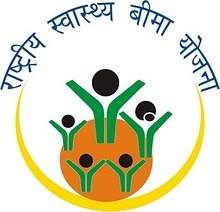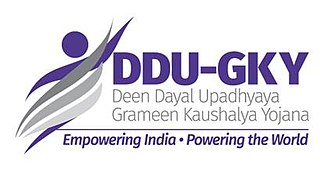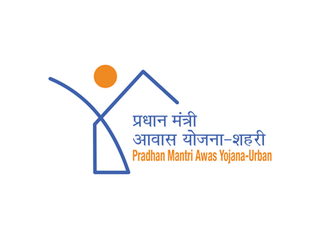Mahatma Gandhi National Rural Employment Guarantee Act 2005 or MGNREGA, earlier known as the National Rural Employment Guarantee Act or NREGA, is an Indian social welfare measure that aims to guarantee the 'right to work'. This act was passed on 23 August 2005 and was implemented in February 2006 under the UPA government of Prime Minister Manmohan Singh following tabling of the bill in parliament by the Minister for Rural Development Raghuvansh Prasad Singh.
The Sampoorna Grameen Rozgar Yojana was a scheme launched by the Government of India to gain the objective of providing gainful employment for the rural poor. From 21 February 2003, EAS became an allocation-based scheme. The programme was implemented through the Panchayati Raj institutions.
Social security in India includes a variety of statutory insurances and social grant schemes bundled into a formerly complex and fragmented system run by the Indian government at the federal and the state level. The Directive Principles of State Policy, enshrined in Part IV of the Indian Constitution reflects that India is a welfare state. Food security to all Indians are guaranteed under the National Food Security Act, 2013 where the government provides highly subsidised food grains or a food security allowance to economically vulnerable people. The system has since been universalised with the passing of The Code on Social Security, 2020. These cover most of the Indian population with social protection in various situations in their lives.
Prime Minister’s New 15 point Programme for minorities is a programme launched by Indian government for welfare of religious minorities in furtherance of reports by committees such as the Sachar Committee Report that highlighted that minorities, especially Muslims, in the country were often in a worse socio-economic and political condition than communities such as the Scheduled Casts and Scheduled tribes communities that have been oppressed over millennia through the caste system. It pegged the status of minorities on various indicators such as nutrition, health, education et al. of minorities and specially Muslims at an abysmally poor level. The 15 point program was the government's response to these finding by laying down guidelines to target minorities in schemes and entitlements that are already in place and designing and executing new schemes aimed at the empowerment of these groups. The programme advocated allocating 15% of plan outlays of welfare schemes identified under the 15 point programme. Mainly, issues of education, credit, housing, employment and communal harmony fall under its ambit.

Below Poverty Line is a benchmark used by the government of India to indicate economic disadvantage and to identify individuals and households in need of government assistance and aid. It is determined using various parameters which vary from state to state and within states. The present criteria are based on a survey conducted in 2002. Going into a survey due for a decade, India's central government is undecided on criteria to identify families below poverty line.

Rashtriya Swasthya Bima Yojana is a government-run health insurance programme for the Indian poor. The scheme aims to provide health insurance coverage to the unrecognised sector workers belonging to the BPL category and their family members shall be beneficiaries under this scheme. It provides for cashless insurance for hospitalisation in public as well as private hospitals. The scheme started enrolling on April 1, 2008 and has been implemented in 25 states of India. A total of 36 million families have been enrolled as of February 2014. Initially, RSBY was a project under the Ministry of Labour and Employment. Now it has been transferred to Ministry of Health and Family Welfare from April 1, 2015

Pradhan Mantri Gramin Aawas Yojana, previously Indira Awas Yojana, is a social welfare programme, created by the Indian Government, to provide housing for the rural poor in India. A similar scheme for urban poor was launched in 2015 as Housing for All by 2022. Indira Awas Yojana was launched in 1985 by Rajiv Gandhi, the Prime Minister of India, as one of the major flagship programs of the Ministry of Rural Development to construct houses for the Below Poverty Line population in the villages.
Pradhan Mantri Adarsh Gram Yojana (PMAGY) is a rural development programme launched by the central government in India in the financial year 2009–10 for the development of villages having a higher ratio of people belonging to the scheduled castes through convergence of central and state schemes and allocating financial funding on a per village basis.
The National Rural Livelihood Mission (NRLM) is a poverty alleviation project implemented by the Ministry of Rural Development, a branch of the Government of India. This plan is focused on promoting self-employment and the organization of rural poor. The idea behind this program is to organize the poor into Self Help Groups (SHGs) and make them capable of self-employment. In 1999, after restructuring the Integrated Rural Development Programme (IRDP), the Ministry of Rural Development (MoRD) launched Swarnajayanti Grameen Swarojgar Yojana (SGSY) to focus on promoting self-employment among the rural poor. SGSY is now remodelled to form NRLM, thereby plugging the shortfalls of the SGSY programme. This program was launched in 2011 with a budget of $5.1 billion and is one of the flagship programs of the Ministry of Rural Development. This is one of the world's most prominent initiatives to improve the livelihood of the poor. This program is supported by the World Bank with a credit of $1 Billion. The program was succeeded by Deen Dayal Antyodaya Yojana on 25 September 2015.
Vocational education is that form of instruction designed to prepare people for industrial or commercial employment. It can be acquired either formally in trade schools, technical secondary schools, or in on-the-job training programs or, more informally, by picking up the necessary skills on the job.
Statistics on unemployment in India had traditionally been collected, compiled and disseminated once every ten years by the Ministry of Labour and Employment (MLE), primarily from sample studies conducted by the National Sample Survey Office. Other than these 5-year sample studies, India has – except since 2017 – never routinely collected monthly, quarterly or yearly nationwide employment and unemployment statistics. In 2016, Centre for Monitoring Indian Economy – a non-government entity based in Mumbai, started sampling and publishing monthly unemployment in India statistics.
Deen Dayal Antyodaya Yojana or DAY is one of the Government of India scheme for helping the poor by providing skill training. It replaces Aajeevik. The Government of India has provisioned ₹500 crore (US$63 million) for the scheme. The objective of the scheme is to train 0.5 million people in urban areas per annum from 2016. In rural areas the objective is to train 1 million people by 2017. Further, in urban areas, services like SHG promotion, training centres, vendors markets, and permanent shelters for homeless. The aim of the scheme is skill development of both rural and urban India as per requisite international standards.

Grameen Kaushalya Yojana or DDU-GKY is a Government of India youth employment scheme.

Pradhan Mantri Awas Yojana (PMAY) is a credit-linked subsidy scheme by the Government of India to facilitate access to affordable housing for the low and moderate-income residents of the country. It envisaged a target of building 2 crore (20 million) affordable houses by 31 March 2022. It has two components: Pradhan Mantri Awas Yojana(Urban) (PMAY-U) for the urban poor and Pradhan Mantri Awaas Yojana (Gramin) (PMAY-G and also PMAY-R) for the rural poor, the former administered by Ministry of Housing and Urban Affairs and the latter by Ministry of Rural Development. This scheme converges with other schemes to ensure houses have a toilet, Saubhagya Scheme for universal electricity connection, Ujjwala Yojana LPG connection, access to drinking water and Jan Dhan banking facilities, etc.

Skill India or the National Skills Development Mission of India is a campaign launched by Prime Minister Narendra Modi. It is managed by the National Skills Development Corporation of India.
Rajesh Agarwal, State Finance minister of Uttar Pradesh announced the Uttar Pradesh Budget for 2017-18 on 11 July 2017. The size of the budget presented is ₹3 lakh 84 thousand 659 million 71 lakh. It can be read as rupees. This is 10.9% more than the 2016-17 budget. The fiscal deficit of ₹42,967.86 crore, which is 2.97% of the gross state domestic product, is well below the target of 3% set under the Fiscal Responsibility and Budget Management (FRBM) Act.
Urban Development Directorate (UDD) is the administrative department in the state of Uttarakhand. It is an autonomous state government agency responsible for urban planning and development control. There are 92 Urban Local Bodies in the state of Uttarakhand i.e. 8 Municipal Corporations, 41 Municipal Councils and 43 Town Panchayats.

The Third Ashok Gehlot ministry is the state cabinet of the Indian state of Rajasthan in the 15th Rajasthan Legislative Assembly headed by Chief Minister Ashok Gehlot.
National Action Plan for Climate Change (NAPCC) is a Government of India's programme launched in 2008 to mitigate and adapt to the adverse impact of climate change. The action plan is designed and published under the guidance of Prime Minister’s Council on Climate Change (PMCCC). The 8 sub-missions aimed at fulfilling India's developmental objectives with focus on reducing emission intensity of its economy. The plan will rely on the support from the developed countries with the prime focus of keeping its carbon emissions below the developed economies at any point of time. The 8 missions under NAPCC are as follows:






